
A catamaran is a watercraft with two parallel hulls of equal size. The distance between a catamaran's hulls imparts resistance to rolling and overturning. Catamarans typically have less hull volume, smaller displacement, and shallower draft (draught) than monohulls of comparable length. The two hulls combined also often have a smaller hydrodynamic resistance than comparable monohulls, requiring less propulsive power from either sails or motors. The catamaran's wider stance on the water can reduce both heeling and wave-induced motion, as compared with a monohull, and can give reduced wakes.

The Enterprise is a Bermuda rigged sailing dinghy with a double-chined hull and distinctive blue sails. Normally crewed by two, and sometimes carrying a third crew member, it may also be sailed single-handed.

The Laser is a class of single-handed, one-design sailing dinghies using a common hull design with three interchangeable rigs of different sail areas, appropriate to a given combination of wind strength and crew weight. Ian Bruce and Bruce Kirby designed the Laser in 1970 with an emphasis on simplicity and performance.
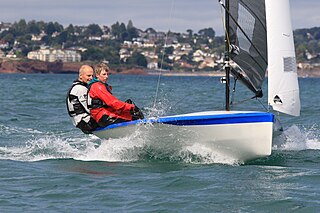
The National 12 is a two-person, two-sail, twelve-foot long sailing dinghy. They are sailed extensively in the UK. The class was started in 1936 by the Royal Yachting Association as an alternative to the more expensive International 14s.
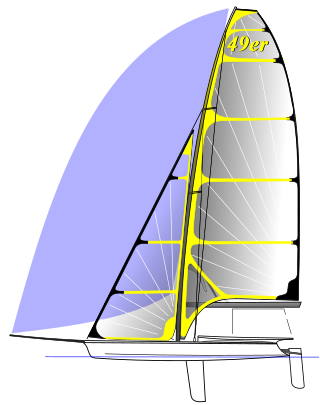
The 49er and 49er FX is a two-handed skiff-type high-performance sailing dinghy. The two crew work on different roles with the helm making many tactical decisions, as well as steering, and the crew doing most of the sail control. Both of the crew are equipped with their own trapeze and sailing is done while cantilevered over the water to the fullest extent to balance against the sails.

The ISAF International Class Hobie 16 (H16) is a popular catamaran manufactured by the Hobie Cat Company for racing and day sailing. The craft was the driving force behind the popularization of beachcats and was recently inducted into the Sailing Hall of Fame.

Hobie Cat is a company that manufactures sailing catamarans, surfboards, sailboats, kayaks, stand-up paddle boards, and pedalboards as the Hobie Cat Company. It was founded in 1961 by Hobart Alter, who originally manufactured surfboards. Its line of products has included more than twenty sailing craft, plus a variety of other watercraft.
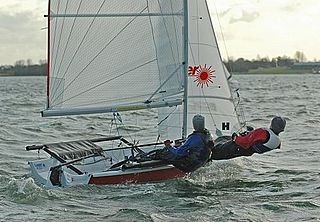
The Laser 4000 is a racing dinghy designed by Phil Morrison crewed by two persons. Its one-design weight-equalised system enables physically differing sailors to compete on a level playing field. It is most popular in Europe, particularly the UK, France and Italy.

The Tasar is a 14.83-foot (4.52 m) fiberglass 2 person sailing dinghy with a mainsail and jib. Designed by Frank Bethwaite of Sydney in 1975, the boat was technologically advanced for its time and continues to evolve. Aimed at a husband-and-wife or parent-and-child crew hence no spinnaker, it is designed for a combined crew weight of around 140 kg. The hull weighs 68 kg, and is of sandwich foam construction. The hull has a fine angle at the bow to reduce wave impact drag with unusually clean and sharp chines aft to ensure very free planing and outstanding stability. The foam cored hull is stiff and light and the advanced hull shape, together with an innovative rig which combines a rotating mast with a fully battened main sail, allows the Tasar to plane upwind with the crew normally hiked. The wide beam and a cockpit designed for comfortable hiking make the Tasar easy, fun and very exciting to sail in winds up to 25 knots (46 km/h).
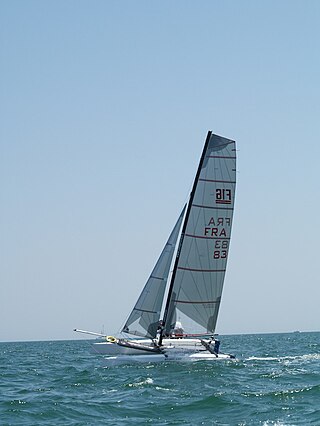
The Formula 16 (F16) sport catamaran is an ISAF recognised 5 m long beach catamaran with an asymmetric spinnaker setup.

The 18 ft Skiff is considered the fastest class of sailing skiffs. The class has a long history beginning with races on Sydney Harbour, Australia in 1892 and later in New Zealand. The boat has changed significantly since the early days, bringing in new technology as it became available. Because of the need of strength, agility and skill, the class is considered to be the top level of small boat sailing. Worldwide this boat is called the "18 Foot Skiff". It is the fastest conventional non-foiling monohull on the yardstick rating, with a score of 675, coming only third after the Tornado and Inter 20.

The International 14 is a British racing sailboat, crewed by two sailors. The class was established in 1928.

The Tempest is a trailerable, one-design racing sailboat that was designed by British naval architect Ian Proctor and first built in 1965.

The International 110 is an American sailboat that was designed by C. Raymond Hunt as a one-design racer and first built in 1939.

The Laser 3000 is a racing sailing dinghy crewed by two persons with a trapeze for the crew. Launched in 1996, the 3000 was developed from the Laser 2, using the original Frank Bethwaite-designed planing hull combined with a brand new self-draining deck by Derek Clark. Clark also re-designed the rig, using spars and sails from premium proprietary sources and replacing the symmetric spinnaker of the Laser 2 by a larger asymmetrical spinnaker. The gennaker is chute-launched and retrieved using a single halyard line, and is set on a retractable bowsprit. Helm balance and handling were improved using a shorter-footed mainsail with two full-width battens giving a larger roach. A mast with conventional spreaders replaced the now-unusual diamond arrangement of the Laser 2.

The 3000 is a racing sailing dinghy crewed by two persons with a trapeze for the crew. Launched in 1996 as the Laser 3000, the 3000 was developed from the Laser 2, using the original Frank Bethwaite-designed planing hull combined with a new designed self-draining deck by Derek Clark. Clark also re-designed the rig, using spars and sails from premium proprietary sources and replacing the symmetric spinnaker of the Laser 2 by a larger asymmetric spinnaker (gennaker). The gennaker is chute-launched and retrieved using a single halyard line, and is set on a retractable bowsprit. Helm balance and handling were improved using a shorter-footed mainsail with two full-width battens giving a larger roach. A mast with conventional spreaders replaced the now-unusual diamond arrangement of the Laser 2.
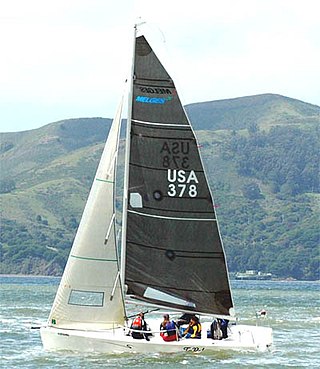
The term sportsboat first appeared in the late 1980s and early 1990s to describe trailer sailers that were optimised for high performance at the expense of accommodation and ballast. The very definition of the term "sportsboat" is evolving.

The Laser Vago is a British/American sailing dinghy that was designed by Jo Richards as a one-design racer and first built in 2005.
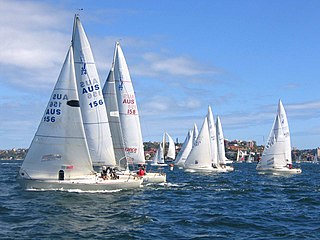
The sport of sailing involves a variety of competitive sailing formats that are sanctioned through various sailing federations and yacht clubs. Racing disciplines include matches within a fleet of sailing craft, between a pair thereof or among teams. Additionally, there are specialized competitions that include setting speed records. Racing formats include both closed courses and point-to-point contests; they may be in sheltered waters, coast-wise or on the open ocean. Most competitions are held within defined classes or ratings that either entail one type of sailing craft to ensure a contest primarily of skill or rating the sailing craft to create classifications or handicaps.
Handicap forms for sailing vessels in sailing races have varied throughout history, and they also vary by country, and by sailing organisation. Sailing handicap standards exist internationally, nationally, and within individual sailing clubs.



















